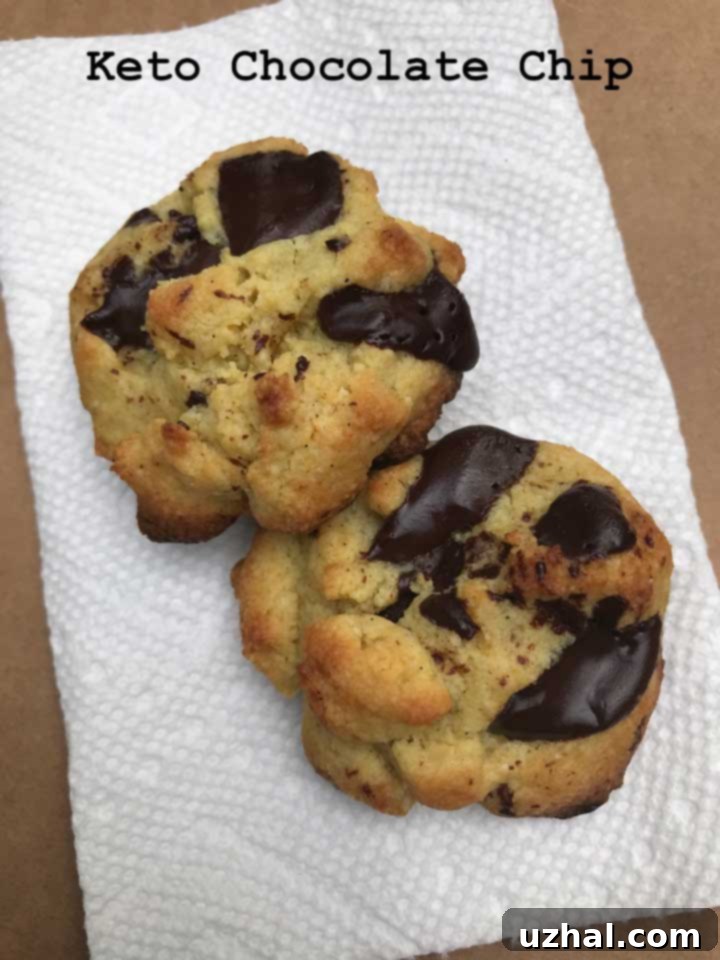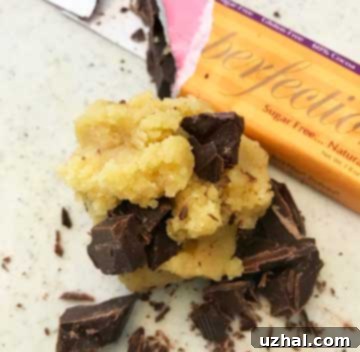The Ultimate Guide to Delicious Keto Chocolate Chip Cookies: Your New Go-To Low-Carb Recipe
If you’ve been on the hunt for the perfect low-carb treat, especially after enjoying the delightful texture of traditional almond flour chocolate chip cookies, then you’ve come to the right place. Our family has rigorously tested countless variations to bring you this winning recipe for keto chocolate chip cookies. It consistently triumphs in taste tests, even among those who aren’t strictly keto, proving that low-carb doesn’t mean low flavor. Prepare to be obsessed with these soft, chewy, and utterly satisfying cookies that perfectly fit a ketogenic lifestyle without sacrificing that classic chocolate chip cookie experience.

Mastering Sweetness: Navigating Keto Dessert Sweeteners
Achieving the right level of sweetness and avoiding off-notes is often the biggest hurdle in keto baking. The world of sugar substitutes can be complex, with each option bringing its own unique characteristics to the table. Our goal is always to create desserts that taste genuinely indulgent, without the usual “keto” compromises. Let’s explore the common sweeteners and why we’ve chosen the blend for these exceptional chocolate chip cookies.
While some people find sucralose acceptable, I’ve personally found it exacerbates my tinnitus, so I tend to avoid it. Xylitol, another popular sugar alcohol, is generally well-regarded for its taste and texture in baking. However, for households with canine companions, xylitol poses a severe and potentially fatal risk if ingested by dogs, making it a non-option for many pet owners, including myself. This leaves us with a select few, each with distinct advantages and considerations: erythritol, erythritol-based blends (like Swerve and Lakanto), stevia, and the increasingly popular allulose.
The Perfect Blend: Erythritol, Stevia, and a Hint of Molasses for Flavor
For these keto chocolate chip cookies, a carefully balanced combination of erythritol and stevia has proven to be the winning formula. Erythritol, a natural sugar alcohol, provides bulk and sweetness without affecting blood sugar levels. It’s nearly as sweet as sugar but has a distinct “cooling” sensation on the palate, which some find off-putting. This is where stevia comes in: a highly potent, natural sweetener derived from the stevia plant. Just a few drops of liquid stevia effectively neutralizes erythritol’s cooling effect, creating a more rounded and sugar-like sweetness profile. This blend ensures your cookies taste genuinely sweet and satisfying, without any lingering strange sensations. Popular erythritol blends like Swerve (which also includes oligosaccharides) and Lakanto Classic (a monk fruit and erythritol blend) also work wonderfully, providing similar results.
You might be surprised to see molasses on the ingredient list, given its carbohydrate content. However, in this recipe, molasses serves a unique purpose entirely separate from sweetening. A mere half-teaspoon is added solely for its rich, complex flavor, which contributes to the traditional “brown sugar” depth often found in classic chocolate chip cookies. When divided among 12 cookies, the carbohydrate contribution from this tiny amount of molasses is truly negligible and won’t impact your keto macros. I’ve experimented with both mild and blackstrap molasses, and surprisingly, mild molasses delivered just as much, if not more, of the desired flavor without being overpowering. Its subtle caramel notes enhance the overall cookie experience, making them taste even more authentic.
Exploring Allulose: A Different Texture Profile
Another fascinating sweetener I thoroughly tested was allulose. Allulose is a “rare sugar” that behaves much like regular sugar in terms of caramelization and texture, making it excellent for applications like smoothies, ice cream, and certain fluffy baked goods. However, its effect on cookies is quite distinct. When used in chocolate chip cookies, allulose tends to create a softer, more cakey, almost muffin-like texture, rather than the chewy or crumbly cookie texture we aimed for with this recipe. While delicious in its own right, it changes the desired outcome significantly.
If you enjoy a softer, cake-like cookie or want to experiment with creating “Keto Muffin Tops,” allulose could be your ideal choice. Just be mindful of its sweetness level: allulose is approximately 70% as sweet as regular sugar, meaning you’ll need to use more of it to achieve the same sweetness. For instance, if a recipe calls for 4 tablespoons of erythritol (which is typically a 1:1 sugar replacement by sweetness), you would need to use about 6 tablespoons of allulose to match that sweetness, while also considering its impact on the final texture. This is a crucial adjustment to remember if you decide to substitute, as using an equal amount by volume will result in a less sweet cookie. You can read more about it here: Allulose Information.

The Best Base: Almond Flour and Other Keto-Friendly Alternatives
Almond flour has become a staple in keto baking, and while it’s incredibly versatile, sometimes I enjoy experimenting with other low-carb flours to vary textures and flavors. For these keto chocolate chip cookies, however, 100% blanched almond flour remains the undisputed champion. Its finely ground texture results in a tender, delicate crumb, and its low carbohydrate content makes it perfect for a keto diet. Furthermore, almond flour cookies often have a delightful characteristic: their texture actually *improves* with time. The longer they sit, especially when stored in an airtight container or zipper bag at room temperature, the softer and more exquisitely crumbly they become. This makes them ideal for meal prep, as they’ll still taste fantastic even a day or two later.
Beyond this pure almond flour version, I’ve explored various blends. One successful variation involved a mixture of almond flour and lupin flour (typically a 2 parts almond flour to 1 part lupin flour ratio). Lupin flour, made from the lupin bean, is another excellent low-carb option that can add protein and fiber, though its distinct flavor can be noticeable and requires careful pairing. Another experiment combined almond flour, coconut flour, and a touch of vital wheat gluten. While coconut flour is highly absorbent and great for some keto recipes, it can lead to a drier texture if not balanced carefully with liquids. Vital wheat gluten, though not strictly keto, can provide elasticity similar to traditional wheat flour in tiny amounts, helping with structure. Ultimately, after extensive testing, the simple, 100% blanched almond flour version consistently delivered the most satisfying and classic chocolate chip cookie taste and texture, making it our top recommendation for this recipe.
Choosing Your Chocolate: Keto-Friendly and Beyond

The chocolate is, of course, a critical component of any chocolate chip cookie. For a truly keto-compliant cookie, sugar-free options are essential. I regularly use brands like Lily’s chocolate chips, which are sweetened with erythritol and stevia, offering a classic chocolate experience without the added sugar. Another excellent choice is chopped keto-friendly chocolate bars, such as Chocoperfection. Chocoperfection, sweetened with inulin, stands out as one of the best-tasting sugar-free chocolates I’ve tried. While it can be a bit more expensive, its rich, authentic chocolate flavor makes it absolutely worth the investment if you’re committed to a strict keto diet and truly miss the indulgence of real chocolate.
It’s also worth noting that sometimes, depending on my dietary flexibility, I might veer slightly off a strict keto path and opt for “cheat-o” cookies. In these instances, I use regular semi-sweet or bittersweet chocolate chips. While these aren’t sugar-free, they significantly lower the overall sugar content compared to traditional cookies, making them a good option for those aiming for a generally lower-sugar intake rather than strict ketosis. This recipe is adaptable, allowing you to choose the chocolate that best fits your current dietary goals and preferences, ensuring a delicious outcome every time.
While I’m incredibly proud of this recipe and confident in its deliciousness, I’m always eager to discover new culinary innovations. The world of keto baking is constantly evolving, and I’m sure there are many other fantastic keto chocolate chip cookie recipes out there that are just as good, or perhaps even offer unique twists. I remain curious and open to exploring them all, but for now, this recipe holds a special place in our family’s hearts and our keto-friendly kitchen.
Small Batch Keto Chocolate Chip Cookies: The Recipe

Small Batch Keto Chocolate Chip Cookies
Anna
Pin Recipe
Ingredients
- 4 tablespoons unsalted butter softened (60 grams), ensuring it’s at room temperature for easy creaming
- 4 tablespoons erythritol (48 grams), or your preferred erythritol blend like Swerve or Lakanto Classic
- ½ teaspoon molasses mild or blackstrap, for depth of flavor (optional for strictest keto, but highly recommended)
- 1-2 drops liquid stevia approximately 1/16 of a teaspoon, to balance erythritol’s cooling effect
- ½ teaspoon vanilla extract pure vanilla extract for best flavor
- 1 large egg at room temperature important for a smooth batter
- ¼ teaspoon baking soda
- ¼ teaspoon salt use half if using salted butter, to taste
- 1 ¼ cups blanched almond flour (130 grams), finely ground for the best texture
- ½ cup sugar-free chocolate chips or chopped keto-friendly chocolate (84 grams), such as Lily’s or Chocoperfection
Instructions
-
Begin by preheating your oven to 350 degrees F (175 degrees C). Prepare a large baking sheet by lining it with parchment paper, which prevents sticking and makes cleanup a breeze.
-
In a medium bowl, cream together the softened unsalted butter, erythritol (or erythritol blend), the small amount of molasses for flavor, and the liquid stevia. Beat these ingredients until the mixture is light and fluffy, ensuring all sweeteners are well incorporated. Add the vanilla extract and mix thoroughly.
-
Next, crack in the room temperature egg and stir until it’s just blended into the butter mixture. Avoid overmixing at this stage. Then, gently beat in the baking soda and salt until evenly distributed.
-
Gradually add the blanched almond flour to the wet ingredients. Stir with a spoon or spatula until the flour is fully blended and a cohesive dough forms. Finally, fold in your sugar-free chocolate chips or chopped chocolate chunks, ensuring they are evenly distributed throughout the dough.
-
Divide the dough into 10 to 12 equal portions and roll them into smooth balls. Arrange these cookie dough balls on your prepared baking sheet, leaving about 2 inches between each to allow for slight spreading. Gently press down on each ball to form ½-inch thick rounds. These cookies don’t spread significantly during baking, so pressing them down helps achieve a desirable flatter, chewier shape. Bake for 12 to 13 minutes, or until the edges are lightly golden brown and the centers are set. Baking times can vary slightly depending on your oven and the brand of almond flour used.
-
Once baked, remove the cookies from the oven and let them cool completely on the baking sheet or a wire rack. This is a crucial step for optimal texture, allowing them to firm up and preventing them from crumbling. For an extra treat, I enjoy placing them in the freezer for a short period to solidify the chocolate, then eating them frozen or letting them return to room temperature where the chocolate remains firm and satisfying. Store cooled cookies in an airtight container at room temperature for up to 3-4 days, or freeze for longer storage.
